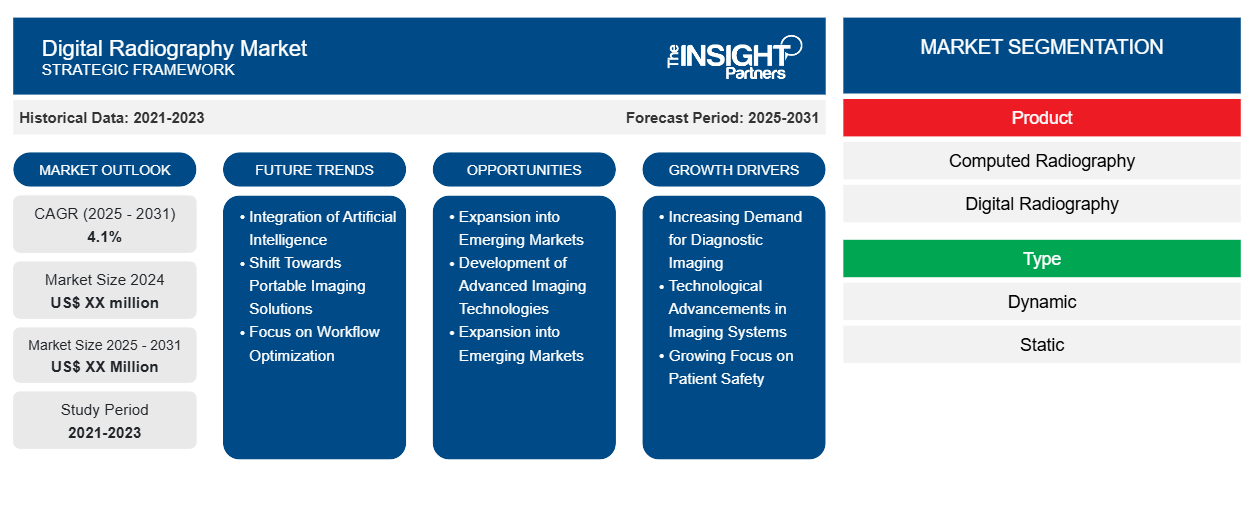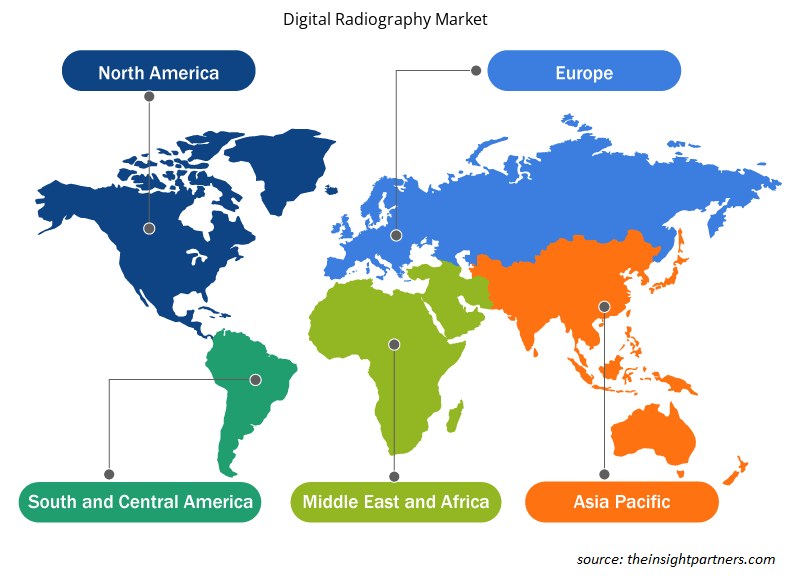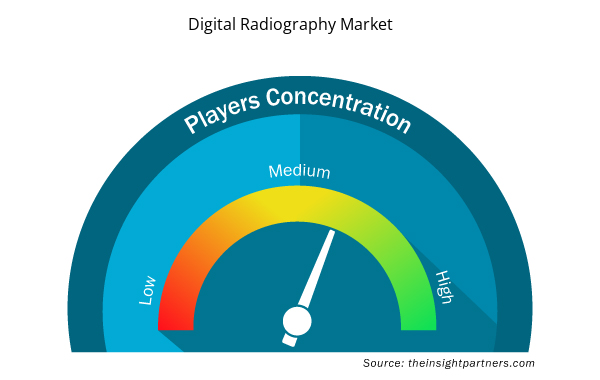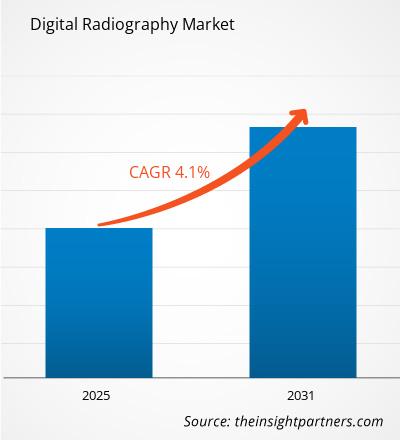Si prevede che il mercato della radiografia digitale registrerà un CAGR del 4,1% dal 2025 al 2031, con una dimensione di mercato in espansione da XX milioni di dollari nel 2024 a XX milioni di dollari entro il 2031.
Il report è segmentato per prodotto (radiografia computerizzata, radiografia digitale); tipo (dinamico, statico); applicazione (radiografia generale, odontoiatria, oncologia, ortopedia, altri); utente finale (ospedali, cliniche, centri diagnostici, altri). L'analisi globale è ulteriormente suddivisa a livello regionale e nei principali paesi. Il report offre il valore in USD per l'analisi e i segmenti di cui sopra.
Scopo del rapporto
Il report Digital Radiography Market di The Insight Partners mira a descrivere il panorama attuale e la crescita futura, i principali fattori trainanti, le sfide e le opportunità. Ciò fornirà spunti a vari stakeholder aziendali, come:
- Fornitori/produttori di tecnologia: per comprendere le dinamiche di mercato in evoluzione e conoscere le potenziali opportunità di crescita, consentendo loro di prendere decisioni strategiche informate.
- Investitori: condurre un'analisi completa delle tendenze relative al tasso di crescita del mercato, alle proiezioni finanziarie del mercato e alle opportunità esistenti lungo la catena del valore.
- Enti di regolamentazione: regolamentano le politiche e le attività di controllo sul mercato allo scopo di ridurre al minimo gli abusi, preservare la fiducia degli investitori e sostenere l'integrità e la stabilità del mercato.
Segmentazione del mercato della radiografia digitale
Prodotto
- Radiografia computerizzata
- Radiografia digitale
Tipo
- Dinamico
- Statico
Applicazione
- Radiografia generale
- Odontoiatria
- Oncologia
- Ortopedico
- Altri
Utente finale
- Ospedali
- Cliniche
- Centri Diagnostici
- Altri
Personalizza questo report in base alle tue esigenze
Riceverai la personalizzazione gratuita di qualsiasi report, comprese parti di questo report, o analisi a livello nazionale, pacchetto dati Excel, oltre a usufruire di grandi offerte e sconti per start-up e università
Mercato della radiografia digitale: approfondimenti strategici

- Scopri le principali tendenze di mercato in questo rapporto.Questo campione GRATUITO includerà analisi di dati che spaziano dalle tendenze di mercato alle stime e alle previsioni.
Driver di crescita del mercato della radiografia digitale
- Domanda crescente di diagnostica per immagini: l'elevata richiesta di radiografia digitale nel settore sanitario è alimentata dalla crescente domanda di soluzioni di diagnostica per immagini. Un numero in rapida crescita di pazienti soffre di malattie croniche e lesioni e ci si aspetta che i fornitori di servizi medici effettuino diagnosi accurate e progettino piani di trattamento con tecnologie di imaging avanzate. La radiografia digitale offre risultati più rapidi, immagini di alta qualità e dosi di radiazioni più piccole e, pertanto, è la modalità preferita per le moderne strutture mediche.
- Progressi tecnologici nei sistemi di imaging: il mercato della radiografia digitale è fortemente influenzato dal rapido sviluppo nel campo tecnico dei sistemi di imaging. Rilevatori migliori, software di elaborazione delle immagini migliorato e capacità di telemedicina integrate con esso sono fattori per cui la radiografia digitale è molto più efficiente e facile da usare. Queste tecnologie non solo migliorano l'accuratezza diagnostica, ma semplificano anche il lavoro negli ambienti sanitari, assorbendo così di più le soluzioni di radiografia digitale.
- Crescente attenzione alla sicurezza del paziente: dal periodo in cui la crescente importanza della sicurezza del paziente insieme alla riduzione dell'esposizione alle radiazioni ha preso il sopravvento come un forte motore del mercato della radiografia digitale. I sistemi digitali introducono basse dosi di radiazioni rispetto ai metodi basati su pellicola. Pertanto, la solita minaccia delle radiazioni per pazienti e personale è mitigata. Con la crescente comprensione dell'importanza della sicurezza dei pazienti, il mercato della radiografia digitale è testimone di una maggiore domanda.
Tendenze future del mercato della radiografia digitale
- Integrazione dell'intelligenza artificiale: l'intelligenza artificiale è un'altra tendenza critica nel mercato della radiografia digitale. Una delle tendenze più brillanti del settore è una tecnologia di imaging integrata con l'intelligenza artificiale. Tale tecnologia può migliorare l'analisi delle immagini basata su tecnologie basate sull'intelligenza artificiale per rendere le diagnosi più rapide e accurate. Questa tendenza non solo migliora l'efficienza del flusso di lavoro, ma supporta anche il radiologo nel presentare risultati migliori e processi diagnostici più semplici.
- Spostamento verso soluzioni di imaging portatili: questo spostamento verso soluzioni di imaging portatili sta quindi modificando l'attuale panorama del mercato della radiografia digitale. Fondamentali nella loro evoluzione per essere più convenienti e accessibili, i sistemi di radiografia digitale portatili stanno ora iniziando a emergere nella fornitura di cure di emergenza e in luoghi remoti. Quindi, tramite l'imaging in loco, è possibile ottenere una migliore assistenza ai pazienti con una riduzione dei tempi di attesa e un maggiore accesso ai servizi diagnostici in molte località.
- Focus sull'ottimizzazione del flusso di lavoro: l'ottimizzazione del flusso di lavoro è stata vista come un fattore di successo nel mercato della radiografia digitale a causa della necessità di efficienza negli ambienti sanitari. I produttori hanno introdotto una migliore efficacia attraverso sistemi che facilitano le procedure di imaging, si abbinano bene alla cartella clinica elettronica del paziente e promuovono una migliore comunicazione tra i team sanitari. Questa tendenza aumenta non solo l'efficienza operativa, ma contribuisce anche a una migliore esperienza per i pazienti in termini di diagnostica.
Opportunità di mercato della radiografia digitale
- Espansione nei mercati emergenti: apre inoltre enormi opportunità di crescita per la radiografia digitale in quei nuovi mercati emergenti in cui l'infrastruttura sanitaria è progressivamente diventata un problema. Infatti, man mano che vengono esercitati sforzi regionali per modernizzare la loro tecnologia medica, le capacità diagnostiche aumenterebbero la domanda di soluzioni di radiografia digitale. Le aziende che si avventurano in tali mercati potrebbero collaborare con i fornitori di assistenza sanitaria di questi luoghi e raccogliere opportunità di crescita dell'assistenza sanitaria.
- Sviluppo di tecnologie di imaging avanzate: le soluzioni di imaging avanzate abbraccerebbero nuove tecnologie digitali, comprese quelle che potrebbero essere immaginate nelle nuove generazioni di radiografia digitale, aprendo nuove strade per lo sviluppo di nuove tecnologie di imaging. L'imaging avanzato fornirà i mezzi per l'imaging 3D, la radiografia a doppia energia e altre tecnologie di rilevamento innovative che offrono prestazioni e risultati diagnostici migliorati. La spesa in R&S in queste soluzioni all'avanguardia costringerà le aziende a svilupparsi ancora di più rispetto alle loro attuali offerte e ad ampliare i limiti per soddisfare le esigenze che i fornitori di servizi sanitari richiedono continuamente.
- Espansione nei mercati emergenti: si apre uno spazio per espandere il mercato attraverso l'integrazione di soluzioni di telemedicina con la radiografia digitale. L'avanzamento dei miglioramenti nella telemedicina può andare di pari passo con l'espansione dell'assistenza ai pazienti attraverso l'integrazione della capacità di imaging e delle consultazioni a distanza. Lo spazio sempre più ampio nella telemedicina verrebbe catturato dalle aziende nello sviluppo di sistemi che renderebbero facile la condivisione delle immagini radiografiche tra diversi operatori sanitari e pazienti.
Approfondimenti regionali sul mercato della radiografia digitale
Le tendenze regionali e i fattori che influenzano il mercato della radiografia digitale durante il periodo di previsione sono stati ampiamente spiegati dagli analisti di Insight Partners. Questa sezione discute anche i segmenti e la geografia del mercato della radiografia digitale in Nord America, Europa, Asia Pacifico, Medio Oriente e Africa e America meridionale e centrale.

- Ottieni i dati specifici regionali per il mercato della radiografia digitale
Ambito del rapporto di mercato sulla radiografia digitale
| Attributo del report | Dettagli |
|---|---|
| Dimensioni del mercato nel 2024 | XX milioni di dollari USA |
| Dimensioni del mercato entro il 2031 | XX milioni di dollari USA |
| CAGR globale (2025 - 2031) | 4,1% |
| Dati storici | 2021-2023 |
| Periodo di previsione | 2025-2031 |
| Segmenti coperti | Per Prodotto
|
| Regioni e Paesi coperti | America del Nord
|
| Leader di mercato e profili aziendali chiave |
|
Densità degli attori del mercato della radiografia digitale: comprendere il suo impatto sulle dinamiche aziendali
Il mercato della radiografia digitale sta crescendo rapidamente, spinto dalla crescente domanda degli utenti finali dovuta a fattori quali l'evoluzione delle preferenze dei consumatori, i progressi tecnologici e una maggiore consapevolezza dei vantaggi del prodotto. Con l'aumento della domanda, le aziende stanno ampliando le loro offerte, innovando per soddisfare le esigenze dei consumatori e capitalizzando sulle tendenze emergenti, il che alimenta ulteriormente la crescita del mercato.
La densità degli operatori di mercato si riferisce alla distribuzione di aziende o società che operano in un particolare mercato o settore. Indica quanti concorrenti (operatori di mercato) sono presenti in un dato spazio di mercato in relazione alle sue dimensioni o al valore di mercato totale.
Le principali aziende che operano nel mercato della radiografia digitale sono:
- Radiografia 3DX
- Bosello Alta Tecnologia srl
- Canone, Inc.
- Salute Carestream
- Fresenius Se & Co. KGaA
Disclaimer : le aziende elencate sopra non sono classificate secondo un ordine particolare.

- Ottieni una panoramica dei principali attori del mercato della radiografia digitale
Punti di forza chiave
- Copertura completa: il rapporto affronta in modo completo l'analisi di prodotti, servizi, tipologie e utenti finali del mercato della radiografia digitale, fornendo una panoramica olistica.
- Analisi degli esperti: il rapporto è compilato sulla base della conoscenza approfondita di esperti e analisti del settore.
- Informazioni aggiornate: il rapporto garantisce la pertinenza aziendale grazie alla copertura di informazioni recenti e tendenze nei dati.
- Opzioni di personalizzazione: questo report può essere personalizzato per soddisfare le esigenze specifiche del cliente e adattarsi in modo appropriato alle strategie aziendali.
Il rapporto di ricerca sul mercato della radiografia digitale può quindi aiutare a guidare il percorso di decodifica e comprensione dello scenario del settore e delle prospettive di crescita. Sebbene possano esserci alcune preoccupazioni valide, i vantaggi complessivi di questo rapporto tendono a superare gli svantaggi.
- Analisi storica (2 anni), anno base, previsione (7 anni) con CAGR
- Analisi PEST e SWOT
- Valore/volume delle dimensioni del mercato - Globale, regionale, nazionale
- Industria e panorama competitivo
- Set di dati Excel



Report Coverage
Revenue forecast, Company Analysis, Industry landscape, Growth factors, and Trends

Segment Covered
This text is related
to segments covered.

Regional Scope
North America, Europe, Asia Pacific, Middle East & Africa, South & Central America

Country Scope
This text is related
to country scope.
Domande frequenti
increasing demand for diagnostic imaging and technological advancement in imaging systems are the major factors boosting the digital radiography market growth
3DX-Ray, Bosello High Technology srl, Canon, Inc, Carestream Health, Fresenius Se & Co. KGaA, FUJIFILM Holdings Corporation, Koninklijke Philips N.V., North Star Imaging Inc, Shimadzu Corporation, Toshiba Medical System Corporation are the some of the key market players operating in the digital radiography market
The market is expected to grow at a CAGR of 4.1%
The final report will duly include market size and projection estimates for all the segments from 2021 to 2031, along with a revenue share and compound annual growth rate (%) for the regional/country-wise market wherein 2021-2022 are the historic years, 2023 is considered to be the base year, and the forecast will be provided till 2031, along with CAGR (%)
The North America region accounts for highest revenue share digital radiography market
Asia Pacific is estimated to grow at the highest CAGR over the forecast year (2023 - 2031)
Trends and growth analysis reports related to Life Sciences : READ MORE..
1. 3DX-Ray
2. Bosello High Technology srl
3. Canon, Inc
4. Carestream Health
5. Fresenius Se & Co. KGaA
6. FUJIFILM Holdings Corporation
7. Koninklijke Philips N.V.
8. North Star Imaging Inc.
9. Shimadzu Corporation
10. Toshiba Medical System Corporation
The Insight Partners performs research in 4 major stages: Data Collection & Secondary Research, Primary Research, Data Analysis and Data Triangulation & Final Review.
- Data Collection and Secondary Research:
As a market research and consulting firm operating from a decade, we have published and advised several client across the globe. First step for any study will start with an assessment of currently available data and insights from existing reports. Further, historical and current market information is collected from Investor Presentations, Annual Reports, SEC Filings, etc., and other information related to company’s performance and market positioning are gathered from Paid Databases (Factiva, Hoovers, and Reuters) and various other publications available in public domain.
Several associations trade associates, technical forums, institutes, societies and organization are accessed to gain technical as well as market related insights through their publications such as research papers, blogs and press releases related to the studies are referred to get cues about the market. Further, white papers, journals, magazines, and other news articles published in last 3 years are scrutinized and analyzed to understand the current market trends.
- Primary Research:
The primarily interview analysis comprise of data obtained from industry participants interview and answers to survey questions gathered by in-house primary team.
For primary research, interviews are conducted with industry experts/CEOs/Marketing Managers/VPs/Subject Matter Experts from both demand and supply side to get a 360-degree view of the market. The primary team conducts several interviews based on the complexity of the markets to understand the various market trends and dynamics which makes research more credible and precise.
A typical research interview fulfils the following functions:
- Provides first-hand information on the market size, market trends, growth trends, competitive landscape, and outlook
- Validates and strengthens in-house secondary research findings
- Develops the analysis team’s expertise and market understanding
Primary research involves email interactions and telephone interviews for each market, category, segment, and sub-segment across geographies. The participants who typically take part in such a process include, but are not limited to:
- Industry participants: VPs, business development managers, market intelligence managers and national sales managers
- Outside experts: Valuation experts, research analysts and key opinion leaders specializing in the electronics and semiconductor industry.
Below is the breakup of our primary respondents by company, designation, and region:

Once we receive the confirmation from primary research sources or primary respondents, we finalize the base year market estimation and forecast the data as per the macroeconomic and microeconomic factors assessed during data collection.
- Data Analysis:
Once data is validated through both secondary as well as primary respondents, we finalize the market estimations by hypothesis formulation and factor analysis at regional and country level.
- Macro-Economic Factor Analysis:
We analyse macroeconomic indicators such the gross domestic product (GDP), increase in the demand for goods and services across industries, technological advancement, regional economic growth, governmental policies, the influence of COVID-19, PEST analysis, and other aspects. This analysis aids in setting benchmarks for various nations/regions and approximating market splits. Additionally, the general trend of the aforementioned components aid in determining the market's development possibilities.
- Country Level Data:
Various factors that are especially aligned to the country are taken into account to determine the market size for a certain area and country, including the presence of vendors, such as headquarters and offices, the country's GDP, demand patterns, and industry growth. To comprehend the market dynamics for the nation, a number of growth variables, inhibitors, application areas, and current market trends are researched. The aforementioned elements aid in determining the country's overall market's growth potential.
- Company Profile:
The “Table of Contents” is formulated by listing and analyzing more than 25 - 30 companies operating in the market ecosystem across geographies. However, we profile only 10 companies as a standard practice in our syndicate reports. These 10 companies comprise leading, emerging, and regional players. Nonetheless, our analysis is not restricted to the 10 listed companies, we also analyze other companies present in the market to develop a holistic view and understand the prevailing trends. The “Company Profiles” section in the report covers key facts, business description, products & services, financial information, SWOT analysis, and key developments. The financial information presented is extracted from the annual reports and official documents of the publicly listed companies. Upon collecting the information for the sections of respective companies, we verify them via various primary sources and then compile the data in respective company profiles. The company level information helps us in deriving the base number as well as in forecasting the market size.
- Developing Base Number:
Aggregation of sales statistics (2020-2022) and macro-economic factor, and other secondary and primary research insights are utilized to arrive at base number and related market shares for 2022. The data gaps are identified in this step and relevant market data is analyzed, collected from paid primary interviews or databases. On finalizing the base year market size, forecasts are developed on the basis of macro-economic, industry and market growth factors and company level analysis.
- Data Triangulation and Final Review:
The market findings and base year market size calculations are validated from supply as well as demand side. Demand side validations are based on macro-economic factor analysis and benchmarks for respective regions and countries. In case of supply side validations, revenues of major companies are estimated (in case not available) based on industry benchmark, approximate number of employees, product portfolio, and primary interviews revenues are gathered. Further revenue from target product/service segment is assessed to avoid overshooting of market statistics. In case of heavy deviations between supply and demand side values, all thes steps are repeated to achieve synchronization.
We follow an iterative model, wherein we share our research findings with Subject Matter Experts (SME’s) and Key Opinion Leaders (KOLs) until consensus view of the market is not formulated – this model negates any drastic deviation in the opinions of experts. Only validated and universally acceptable research findings are quoted in our reports.
We have important check points that we use to validate our research findings – which we call – data triangulation, where we validate the information, we generate from secondary sources with primary interviews and then we re-validate with our internal data bases and Subject matter experts. This comprehensive model enables us to deliver high quality, reliable data in shortest possible time.

 Ottieni un campione gratuito per questo repot
Ottieni un campione gratuito per questo repot